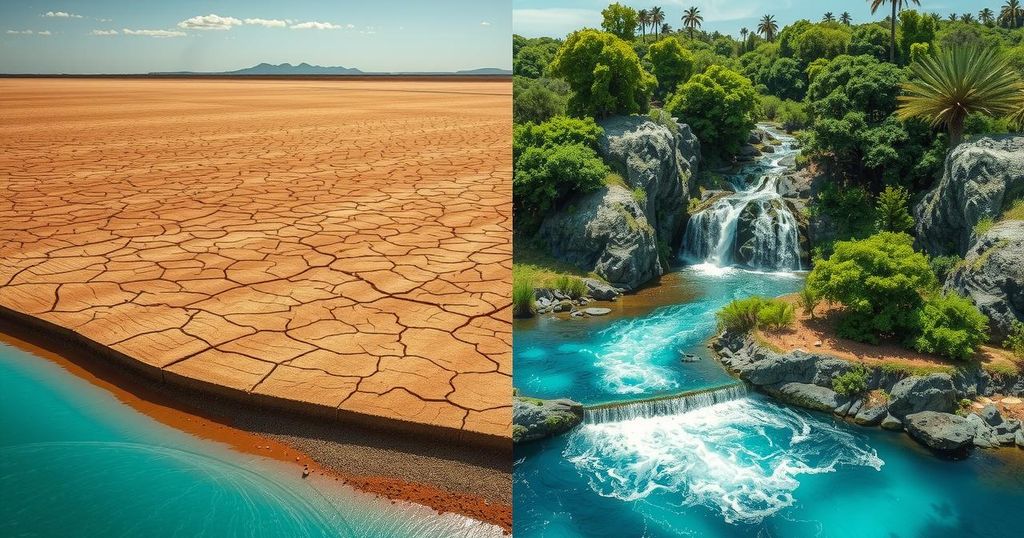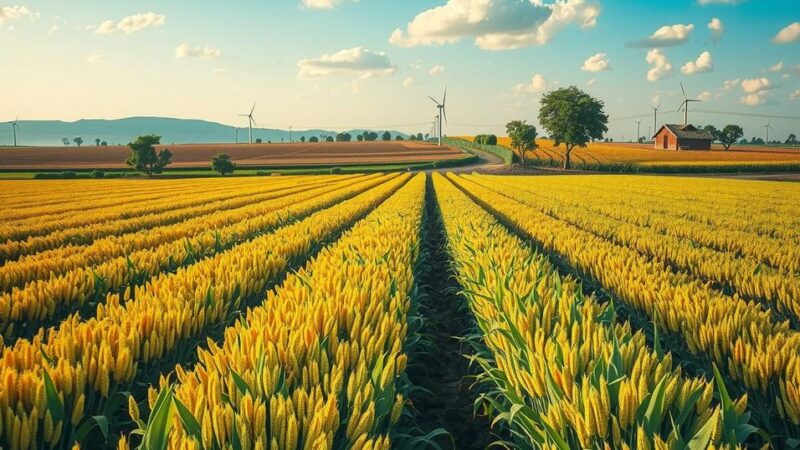A recent study in *Nature* indicates that climate change is intensifying water scarcities in some regions while alleviating them in others, necessitating different adaptation strategies. Countries like India may face greater scarcities, while others, such as Nigeria, could see benefits from climate-induced precipitation changes. The study emphasizes the importance of quantifying water gaps for effective decision-making and regional planning in a warming world.
The distribution of water resources globally is marked by significant inequities, leading to varying levels of water scarcity across regions. Recent findings published in the journal Nature indicate that climate change and global warming are anticipated to worsen these disparities, demanding tailored adaptation strategies for different nations. Countries such as India are expected to experience an increase in water scarcity, while others like Nigeria and Sudan may benefit from changes in precipitation patterns. It is important to note that these trends might evolve over time for the same water basins.
The growing water gaps could intensify conflicts and regional tensions, particularly in politically volatile areas. This issue was highlighted in a report from the United Nations Convention to Combat Desertification (UNCCD), which emphasized that increased resource pressure leads to elevated conflicts. The report underlined the necessity for policy planning specific to various regions due to their diverse circumstances.
Planning for these challenges requires reliable data. Currently, a significant portion of Nature-Based Solutions aimed at enhancing water security and addressing land degradation occurs in the Asia-Pacific region, notably in India through the Mahatma Gandhi National Rural Employment Guarantee Scheme (MGNREGS), as noted in a UNCCD report released during the 16th Conference of Parties in Riyadh. Despite these initiatives, cities in India continue to face water scarcity issues.
Co-authored by Lorenzo Rosa and Matteo Sangiorgio, the Nature study emphasizes the importance of quantifying and forecasting future water scenarios for effective planning. The authors highlight that, while data on groundwater and environmental flow is available, there is a pressing need to assess past and future conditions to inform decision-making and respond effectively to water scarcity amid uncertainties.
A water gap represents the deficit where available water for use is less than the demand. The study evaluates these gaps in cubic kilometers at major hydrological basins, employing a multi-model approach for assessing past and predictive future conditions, accounting for all ecosystem requirements. This includes surface water, groundwater, and environmental flows to provide a comprehensive understanding of regional water availability.
Utilizing five climate models from the Coupled Model Intercomparison Project (CMIP6), the study simulates various scenarios for future water conditions. Water gaps are calculated with a high-resolution grid, allowing for a nuanced understanding of regional variations in water availability under different climate scenarios. The study looks at temperature benchmarks comparing to baseline scenarios and projected increases, underscoring varying impacts across regions.
The findings reveal that global warming is expanding water gaps in various areas, including California’s Central Valley, Saudi Arabia, and the Indo-Gangetic Plains in India and Pakistan. Under a three-degree warming scenario, certain regions currently unaffected by water scarcity—including parts of the United States—may experience significant declines in water availability.
Rosa, in an interview with Down to Earth, noted that India faces a more severe risk of water scarcity compared to other regions, citing higher irrigation demands. The simulations indicate that India will experience an additional water deficit of 11.1 cubic kilometers per year under a 1.5°C scenario, surpassing projected deficits for China. Regional precipitation patterns significantly influence these outcomes.
The study indicates that South Asia, particularly India, Pakistan, and Bangladesh, will be the most adversely impacted regions, suggesting that successful programs like MGNREGS should be expanded to create livelihoods, prevent migration, and improve resilience to climate change.
The research advocates for sustainable agricultural practices, enhanced water harvesting, and the strategic reuse of treated wastewater to alleviate pressure on groundwater. While countries like the Philippines and Vietnam may see improved water availability, they also face potential flood risks. The MENA and Mediterranean regions are projected to encounter growing water stress, necessitating interventions akin to those recommended for South Asia.
Rather than focusing solely on short-term responses, there is a strong call for the sustainable use of resources and improved agricultural practices across all affected regions. Ensuring water safety and harvesting methods must be prioritized to alleviate dependence on groundwater. The study also highlights the limitations of current models due to unpredictable rainfall patterns, calling for more comprehensive monitoring and data validation in future research.
In summary, the recent study elucidates the stark disparities in global water availability exacerbated by climate change, highlighting the critical need for region-specific strategies. Countries such as India face significant challenges in managing water scarcity, while some regions might experience improved conditions. Strategies include expanding successful water management programs, promoting sustainable agricultural practices, and enhancing water conservation measures. By addressing these issues holistically, nations can mitigate future conflicts and ensure water security for their populations.
Original Source: www.downtoearth.org.in






